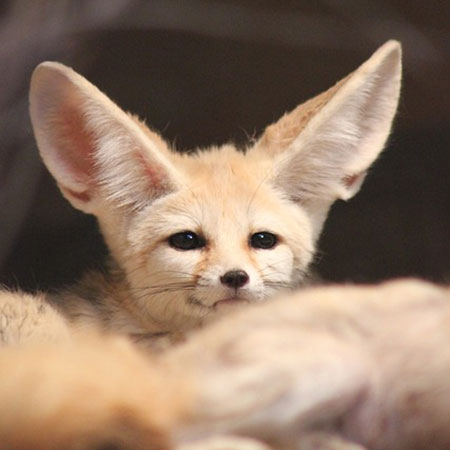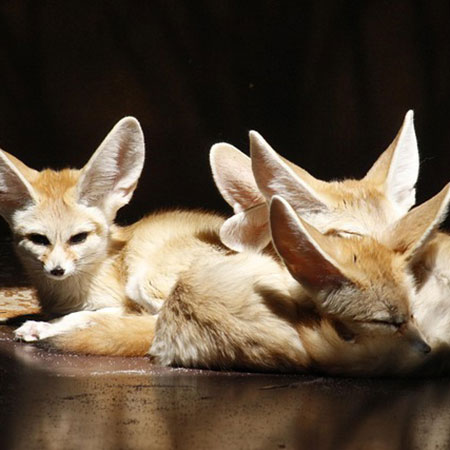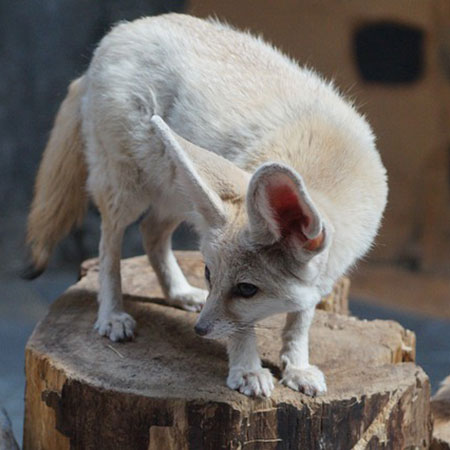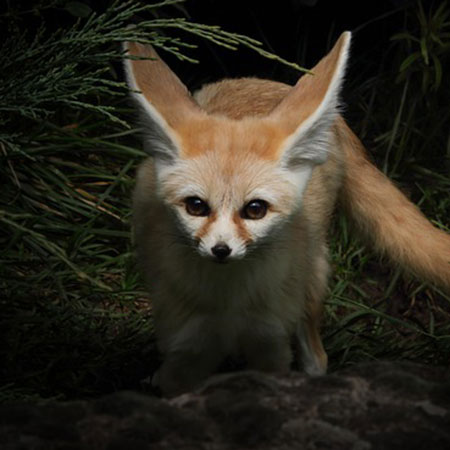General Information
The Fennic Fox is a small mammal in the Canidae family along with other foxes, dogs and wolves. It has a dog type of body and a personality more like a cat. They are desert animals and are found in areas of North Africa and parts of Asia.
Appearance
Fennic foxes are anywhere from a cream to a sandy color. Their bodies are long and lean, and they have a bushy tail. They are known for their very large ears, which help them to dissipate the high temperatures of the desert, and they also help them to hear their prey underground. Their woolly undercoat helps to protect them from the heat. They have fur on the bottom of their feet to help them not get burned by the hot desert temperatures.
Lifespan
The fennec fox can live approximately. 10-14 years in captivity and approximately 10 years in the wild.
Habitat
They live in the deserts of Asia and Northern Africa.
Diet
They are Omnivores; they eat small rodents, birds, eggs, lizards, plants, and fruits and vegetables.
Reproduction
The Fennic fox reaches sexual maturity at approximately 9-12 months. Gestation is approx. 50-52 days. Females give birth to 1-4 kits. They usually breed only once a year.
Other facts
The fennic fox is very fast and agile, a good climber, and can create extensive burrows. They communicate with each other purrs like a cat, barking, yapping, and higher-pitched squeaks. They also communicate with body language. They are social animals. Their social structure usually consists of the mated pair and their offspring.
Basic Care
Feeding
The fennic fox is omnivorous. They eat small rodents, insects, lizards, eggs, fruits, vegetables, and plants. Captive foxes can tend to be underweight or overweight, so you will have to figure out what works best for your fox. They are like dogs, but a diet of just dog food is not good for them. You will need to give them a variety. Mazuri Exotic canine is a good base for a high-quality dog food, such as Royal Canine or Science Diet, can be used. The base should be 30-50% of their diet. Also provide them with 10-20% fresh fruits and vegetables and 5-15% prey such as mice or insects. They will also need a supplement of Taurine, which can be found in the vitamin section or chicken hearts are a good source of Taurine.
Water
Provide fresh water daily. A bowl that clips to the cage will help prevent them from knocking the water bowl over.
Cleanliness
Clean the enclosure daily.
Enclosure
The enclosure needs to provide your fox with enough room to exercise, including structures for them to climb on, ramps, and platforms. The enclosure must be structured so that the fox cannot dig under the fence or climb out of the top.
Temperature
Fennic foxes are desert animals and they have specific temperature needs. They should not be kept at temperatures less than 68 degrees. Even though they are desert animals, they are also sensitive to extreme heat. Temperatures for an extended time over 87 degrees can also be stressful to them.
Exercise
The fennic fox will get exercise by running, jumping, and playing with other foxes. They are most active at night and in the evening.
Handling
It is important to socialize your fox. Some like to be handled while others do no. Get them used to a harness, and take them in the car. Clicker training can be helpful while training your fox.
Toileting
You can potty train your fennic fox however, they will probably never be completely trained because they do like to mark.
Enrichment
It is important to keep your Fennic fox busy to keep them out of trouble. They
do like to dig and are known to dig a hole up to 20 feet. You should also provide
them with some areas to dig in, such as a sandbox. Also, provide toys, puzzles,
structures for them to climb on.
Requirements
The enclosure for 1-2 foxes should be at least 6ft x 4ft x 4ft tall, and increase
that by 25% of the original size for each additional fox. You will need to
make the flooring dig-proof, or you can place mesh that goes completely
under the cage. You can then cover the mesh with the flooring material.
The gauge needs to be no more than 14 gauge because they can chew
through the chain link. You will also need to add plenty of enrichments for
them. Things like ramps, platforms, sandboxes, and toys. A dog house is
also required to protect them from the outside elements, so that they can
also relax and sleep. You will also need to supply a nesting box. Make
sure that all platforms, shelters, boxes, etc., can accommodate all the
foxes at the same time.




Basic Care
Feeding
A diet composed of a variety of protein sources such as tilapia, catfish, salmon, crustaceans and other protein sources is required. We also recommend a cat food with urinary tract protection. A healthy otter needs about 350 grams of food per day or up to 20% of its own body weight. However, the age, sex, pregnancy, lactation and the temperature all effect the amount of food needed by the otter.
As a baby you will need to order formula, Day One 30/50 from this site.
https://store.foxvalleynutrition.com/day-one-3050
Water
Also provide fresh water, keep it away from their swimming water. The bowl should be disinfected every day and shaped so that your otter cannot flip it over
Cleanliness
Clean the enclosure daily.
Enclosure
The area should large, stimulating with several hiding places to accommodate you otters.
Temperature
They prefer temps of 75-85 degrees F but can tolerate temps down to 52 degrees F. Their pool water temperature should be at 75-85 degrees F.
Exercise
The otter will get exercise by running, jumping and playing, swimming, climbing, etc..
Handling
Joeys need to be allowed to have uninterrupted sleep between their feedings. Frequent handling or noise ca stress them out and result in injury, serious illness and even death.
Toileting
They are messy and like to smear their feces with their hind legs and tail, They also scent mark with their urine. So daily cleaning of the enclosure is essential.
Enrichment
Otters love to play, they are very social. They are tactile and love playing with items that they can roam around in. We like to give them live fish, that get so excited. They also enjoy finding rocks, marbles, balls and any other objects that they can move around and take in the water with them. These are very inquisitive and agile animals. It is important to socialize them with both other otters, animals and humans.
They require specialized care and knowledge of this animal.
Requirements
In addition to the requirements listed above you will need to have an enclosure that for 1-2 otters that is 10 ft x 10 ft and 6 ft high. It must include devices that provide physical and mental stimulation that is compatible to your otter. Every device must be non-injurious. Examples are boxes, balls, pvc tubing, etc. Each enclosure must also have a shelter, den and nest boxes that can accommodate all the animals in the enclosure. For each additional animal you must increase the enclosure size by 25% of the original floor space
